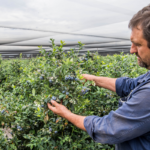Opinion: the scientific case for GM crops

By co-founder and former leader of Greenpeace, and Greenspirit Strategies chief scientist Dr Patrick Moore
 The campaign against genetically modified crops and GM science is both intellectually and morally bankrupt. If it were not such a serious issue, one that means life or death for millions of people, opposition to genetic engineering would be laughable.
The campaign against genetically modified crops and GM science is both intellectually and morally bankrupt. If it were not such a serious issue, one that means life or death for millions of people, opposition to genetic engineering would be laughable.
All genetic modifications being developed around the world are aimed at improving our farms, food and medicine. There are no evil scientists involved and the genetically modified crops are rigorously tested to ensure they will not harm us. Every major academy of science supports genetic modification as a way to address malnutrition and a variety of environmental issues. Genetic modification is the only practical means to address many nutrient deficiencies, including vitamin A, vitamin E, iron and lysine (an amino acid).
Despite its efforts, the anti-GM movement has not stopped the ever-growing acceptance of these new varieties of crops around the world. Genetically modified soybeans, corn, cotton, and canola (rapeseed) led the trend, occupying the majority of the millions of acres of GM crops in 25 countries planted in 2008. Most of the traits in these new varieties are designed to combat insect pests, increase production, and reduce pesticide use. Strong support has come from major seed companies partly because they represent huge volumes and large markets.
GM Hurdles
It has become very expensive to get new GM varieties approved, due mainly to the onerous amount of red tape involved. Every variety is treated as if it were a new pharmaceutical that could have unknown side effects on human health. There is no reason to believe, and no evidence in the facts to assume, that GM foods could be harmful. They are not new drugs; they are new foods. More precisely, they are the same old foods but with a little or a lot of improvement.
Unfortunately Greenpeace and its friends have managed to prevent many varieties of nutritionally improved crops from being planted, even when there is no evidence any harm could result. It will be some time before the international community wakes up and realizes the calamity that it has allowed to occur.
A change of view
But that same international community will inevitably recognize that a great humanitarian error has been made in denying, for example, a cure for nutrient-deficiency-related disease in hundreds of millions of people.
One can predict with some certainty that the area planted in GM varieties will continue to increase. Many new traits, including nutritional improvements, drought tolerance, salt tolerance, enhanced nitrogen uptake, disease resistance, etc., have been developed in a number of crops, including beets, cassava, papaya, potatoes, eggplant, wheat, and rice. Most of these have yet to be introduced due to opposition from anti-GM campaigners. Countries once opposed to GM crops are gradually changing their positions and embracing GM as a key part of agricultural policy. The benefits are so obvious when weighed against the nonexistent 'risks' that anyone with a clear understanding of the precautionary approach would embrace the technology.
Brazil battle
In Brazil, Greenpeace succeeded in getting a judgment from a tribunal in 1999 to prevent the sale of GM soybeans. The government hesitated to step in, as it was typically sensitive to the high-profile attacks against GM foods. Meanwhile farmers in Argentina began to grow GM soybeans in 1996. By 1997 there were more than a million hectares (2.5 million acres) dedicated to producing these soybeans. As Brazil and Argentina share a common border it was not long before truckloads of GM soybean seeds were hauled from Argentina to Brazil, where farmers were eager to benefit from their higher yields. Thus began a long battle between farmers, Greenpeace and its allies, the courts and the government over the legality of GM crops.
In 2003 I traveled to Porto Alegre in southern Brazil, where I addressed a large group of soybean farmers at their union meeting. I encouraged them to continue to defy the edict against GM soy and to take their message directly to the government. Many members of the media attended the meeting and my presentation received extensive coverage. I like to think I had some small role in the outcome that in 2004 the government of then president Lula de Silva finally lifted the ban. As of 2009 more than two-thirds of the Brazilian soybean area was planted with GM varieties. In Argentina, 95% of the soybean area is GM, while in the U.S. 85% is GM. Between them, the U.S., Brazil, and Argentina produce nearly 90% of the world’s soybeans.
Worldwide take up
By the end of 2008 there were 25 countries growing GM crops on 125 million hectares (312 million acres), about the same area as the total annual harvested cropland in the U.S. This is an incredible accomplishment given that the first commercial GM crops were established only 15 years ago. There is every indication this trend will continue. It is likely that long before the end of this century virtually every food crop will have one or more genetically modified traits built into it.
GM technology is so powerful in its potential to improve growth, yield, efficiency, disease resistance, and nutrition that it almost certainly will become universally adopted around the world.
Dr Moore's new book, Confessions of a Greenpeace Dropout: The Making of a Sensible Environmentalist is available at www.sensiblenenvironmentalist.com.












































